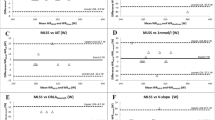Summary
Using an open circuit system (Douglas bag method), measurement of the anaerobic threshold (AT) was performed on ten healthy male college students during an incremental exercise test on a bicycle ergometer in an attempt to determine the validity of this method as compared with arterial blood lactate AT measurement.
Blood samples were taken from either the radial or brachial artery through a Teflon catheter (3 ml/each time) every minute until the subject's maximal exercise tolerance was reached. Blood lactate was analyzed by the enzymatic method.
Differences in work rate, \(\dot V\)O2, %\(\dot V\)O2 max, \(\dot V\) E, HR, and R at AT LA (AT determined by the increase in blood lactate) and at AT GE (gas exchange AT based on the non-linear increases in \(\dot V\) E, \(\dot V\)CO2, and other respiratory parameters), respectively, were all found to be statistically insignificant. There was a significant correlation (r=0.866, p<0.01) between AT LA and AT GE when expressed in \(\dot V\)O2 values (l/min). There was also a significant correlation between AT LA and \(\dot V\)O2 max (r=0.778, p<0.01). These results indicate that the commonly used Douglas bag method could provide a valid non-invasive measure of anaerobic threshold.
Similar content being viewed by others
References
Andersen KL, Shephard RJ, Denolin H, Varnauskas E, Masironi R (1971) Fundamentals of exercise testing. W.H.O. Geneva
åstrand P-O, Rodahl K (1970) Textbook of work physiology. 1st ed. MacGraw-Hill, NewYork
Bouhuys A, Pool J, Binkhorst RA, Leeuwen PV (1966) Metabolic acidosis of exercise in healthy males. J Appl Physiol 21: 1040–1046
Davis JA, Vodak P, Wilmore JH, Vodak J, Kurtz P (1976) Anaerobic threshold and maximal aerobic power for three modes of exercise. J Appl Physiol 41: 544–550
Davis JA, Frank MH, Whipp BJ, Wasserman K (1979) Anaerobic threshold alterations caused by endurance training in middle-aged men. J Appl Physiol: Respirat Environ Exercise Physiol 46: 1039–1046
Ekblom B, åstrand P-O, Saltin B, Stenberg J, Wallström B (1968) Effect of training on circulatory response to exersise. J Appl Physiol 24: 518–528
Issekutz B Jr, Brirkhead NC, Rodahl K (1962) Use of respiratory quotients in assessment at aerobic work capacity. J Appl Physiol 17: 47–50
Ivy JL, Withers RT, Van Handel PJ, Elger DH, Costill DL (1979) Muscle respiratory capacity and fiber type as determinants of lactate threshold. J Appl Physiol: Respirat Environ Exercise Physiol 48: 523–527
Karlsson J (1971) Lactate and phosphagen concentrations in working muscle of man. Acta Physiol Scand [Suppl] 358
Knuttgen H, Saltin B (1972) Muscle metabolites and oxygen uptake in short-term submaximal exercise in man. J Appl Physiol 32: 690–694
MacDougell JD (1977) The anaerobic threshold: its significance for the endurance athlete. Can J Appl Sports Sci 2: 137–140
Máček M, Vávra J (1971) Cardiopulmonary and metabolic changes during exercise in children 6–14 years old. J Appl Physiol 30: 200–204
Mader A, Heck H, Hollman W (1978) Evaluation of lactic acid anaerobic energy contribution by determination of postexercise lactic acid and concentration of ear capillary blood in middle distance runners and swimmers. In: Landry F, Orban WAR (eds) Exercise physiology. 1st ed. Symposia specialists, Miami, pp 187–200
Osnes J-B, Hermansen L (1974) Acid-base balance after maximal exercise of short duration. J Appl Physiol 32: 59–63
Rusko H, Rahkila P, Karvinen E (1980) Anaerobic threshold, skeletal muscle enzymes and fiber composition in young female crosscountry skiers. Acta Physiol Scand 108: 263–268
Saltin B, Hartly H, Kilbom A, åstrand I (1969) Physical training in sedentary middle-aged and older man. II. Oxygen uptake, heart rate and blood lactate concentration at submaximal and maximal exercise. Scand J Clin Lab Invest 24: 323–334
Saltin B, Karlsson J (1971) Muscle ATP, CP and lactate during exercise. In: Pernow B, Saltin B (eds) Muscle metabolism during exercise. Plenum Press, New York, pp 395–339
Shephard RJ (1976) Cardiorespiratory fitness. A new look at maximum oxygen intake. In: Jokl E, Anand RL, Stoboy H (eds) Medicine and sports 9: Advances in exercise physiology. Karger, Basel New York, pp 61–84
Skinner JS, McLellan TH (1980) The transition from aerobic to anaerobic metabolism. Res Q Exercise Sport 51: 234–248
Wasserman K, Van Kessel AL, Burton GG (1967) Interaction of physiological mechanisms during exercise. J Appl Physiol 22: 71–85
Wasserman K, Whipp BJ, Koyal SN, Beaver WL (1973) Anaerobic threshold and respiratory gas exchange during exercise. J Appl Physiol 35: 236–243
Wasserman K, Whipp BJ (1975) Exercise physiology in health and disease. Am Rev Respir Dis 112: 219–249
Weltman A, Katch VL (1979) Relationship between the onset of metabolic acidosis (anaerobic threshold) and maximal oxygen uptake. J Sports Med Phys Fitness 19: 135–142
Williams CG, Whyndham CH, Kok R, von Rahden MJE (1967) Effect of training on maximal oxygen intake and on anaerobic metabolism in man. Int Z Angew Physiol Einschl Arbeitsphysiol 24: 18–23
Yoshida T, Suda Y, Takeuchi N, Nagata A, Muro M (1980) Acid-base balance and anaerobic threshold during progressive incremental exercise. The 35th Congress of Jpn Phys Fitness Sports Med
Author information
Authors and Affiliations
Rights and permissions
About this article
Cite this article
Yoshida, T., Nagata, A., Muro, M. et al. The validity of anaerobic threshold determination by a Douglas bag method compared with arterial blood lactate concentration. Europ. J. Appl. Physiol. 46, 423–430 (1981). https://doi.org/10.1007/BF00422129
Accepted:
Issue Date:
DOI: https://doi.org/10.1007/BF00422129




